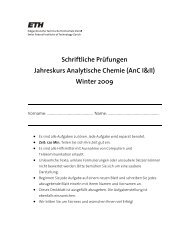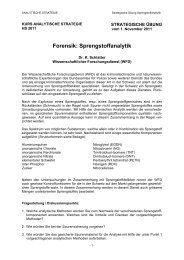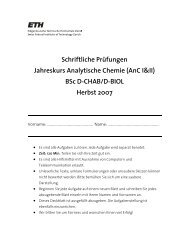View - Renato Zenobi
View - Renato Zenobi
View - Renato Zenobi
You also want an ePaper? Increase the reach of your titles
YUMPU automatically turns print PDFs into web optimized ePapers that Google loves.
Figure 5. Spectrum of cytochrome c demonstrating resolution exceeding 1000 (fwhm). These data were recorded with the delayed extractionsetting optimized for m/z ) 12 000 Da.and sample preparation, one can influence the ratio of ion chargestates, as has been shown briefly in previous works 40 and will bediscussed further in forthcoming publications.The unusually large peak width at the mass of the tetramer isbelieved to be partially due to chemical heterogeneity/posttranslationalmodifications of the monomeric building blocks. Anothercontribution is the setting of the delayed extraction (4 µs), whichwas probably not ideal for the mass of 60 kDa. Using optimizedsettings, much narrower peaks can be obtained. An example of alower mass sample that demonstrates the macromizer’s massresolving power is shown in Figure 5. Here we see a spectrum ofcytochrome c, demonstrating resolution exceeding 1000 (fwhm).Even alkali and matrix adducts can be resolved beside the majorpeak.To demonstrate the high-mass capabilities of the cryodetector,two high-mass proteins were analyzed: IgM and vWF in Figure6. The mass spectra in Figure 6 demonstrate the largest molecularweight of singly charged ions analyzed using MALDI. Obtainingmass calibrants for such a high-mass range can be a challengeby itself. The mass calibration for the data shown here is hencedetermined by extrapolation from lower mass compounds. Althoughour group was unable to detect IgM using a standardcommercial MALDI instrument, high-mass biomolecules havebeen detected using other instruments, 27,41,42 though underextraordinary instrumental circumstances, and at much lowersignal-to-noise levels. Signal can be seen corresponding to IgMat 1 MDa, doubly charged IgM at 500 kDa, triply charged IgM,and even IgM 4+ (Figure 6a). Although these peaks are not wellresolved, there are several possible explanations; most notable isthat the sample was used directly from the supplier with no furtherpurification. Such high-mass proteins are isolated from natural(40) Hilton, G. C.; Martinis, J. M.; Wollman, D. A.; Irwin, K. D.; Dulcie, L. L.;Gerber, D.; Gillevet, P. M.; Twerenbold, D. Nature 1998, 391, 672-675.(41) Nelson, R. W.; Dogruel, D.; Williams, P. Rapid Commun. Mas. Spectrom.1995, 9, 625-625.(42) Berkenkamp, S.; Menzel, C.; Karas, M.; Hillenkamp, F. Rapid Commun.Mass Spectrom. 1997, 11, 1399-1406.sources and may exhibit a considerable degree of chemicalheterogeneity. This is the first commercial instrument capable ofdirectly analyzing singly charged molecules within the megadaltonrange, and there is difficulty obtaining samples that can providenarrow peak widths at such high masses.Another example of the superior capability of the macromizerto detect high-mass ion signals is seen in Figure 6b from a sampleof vWF protein. This sample is an extract of human blood fromvon Willebrand diseased (vWD) patients. vWD patients have anabnormally low multimeric distribution of vWF protein found intheir blood, with vWF protein masses predominately below 10MDa, compared to normal patients, who have distributions of vWFprotein masses between 5 and 20 MDa. 43-45 The vWF is a 550-kDa disulfide-linked homopolymer of two 270-kDa disulfide-linkedmonomers. These dimers then link to form the multimers aidingin blood clotting. Using electrospray ionization, it would bevirtually impossible to distinguish different highly charged vWFoligomers. Figure 6b shows an intense signal at 260 kDa fromthe single vWF protein, a strong signal at 510 kDa from thedisulfide linked dimer, a weaker signal at ∼1 MDa from twodimers, an even weaker signal at 1.5 MDa, and a barely visiblesignal at ∼2 MDa. By accurately distinguishing the multimericdistribution of diseased from normal samples, it is hoped that themacromizer instrument could provide high-throughput analysisof challenging clinical problems using MALDI.CONCLUSIONSA new MALDI mass spectrometer is described for detectinghigh-mass ions. Utilizing the new multichannel array cryodetector,coupled with the ion optics and data acquisition systems incorporatedin the macromizer instrument, the ability to sensitivelydetect high-mass ions is demonstrated. The capability to sensi-(43) Bernardo, A.; Bergeron, A. L.; Sun, C. W.; Guchhait, P.; Cruz, M. A.; Lopez,J. A.; Dong, J. F. J. Thromb. Haemost. 2004, 2, 660-669.(44) Furlan, M. Ann. Hematol. 1996, 72, 341-348.(45) Ohmori, K.; Fretto, L. J.; Harrison, R. L.; Switzer, M. E. P.; Erickson, H. P.;Mckee, P. A. J. Cell Biol. 1982, 95, 632-640.Analytical Chemistry, Vol. 77, No. 14, July 15, 2005 4335









